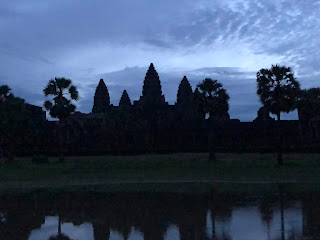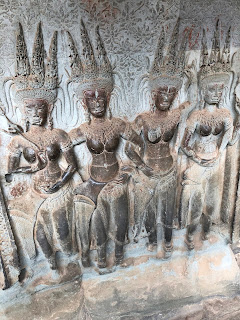Another temple, another bike.
No, I didn't buy another bike--or a temple. (If I could afford to buy a temple, I probably wouldn't have flown economy class!) I did, however, managed to ride third different bike in as many days. After mounting the machines provided by the organizers of the rides I took the previous two days, I did some exploring on this machine.
Here in Siem Reap, as in much of Cambodia, hotels and guest houses have bikes for their guests to use. They are the sorts of bikes ridden by people who live here: heavy and completely utilitarian. Then again, most places charge only a dollar or two a day. The hotel in which I'm staying provided the one in the photo for free.
You can tell this bike was not maintained in any systematic way. Fragments of brackets for parts and accessories long gone are still clamped to the bike in various places. Did the bracket on the front hold a basket? A light? And the old shifter pod on the handlebar: Was it for a three-speed?
The hotel desk manager actually knew enough to fill the tires before letting me ride it. He even helped me to adjust the saddle. And the chain was surprisingly well-oiled. But, as I found out when I dodged a tuk-tuk, a dog and a motorbike at the same time, about a kilometer from the hotel, the brakes weren't.
Fortunately, I found a hardware stall in a market strip. The gentleman tried three different wrenches, all brand-new, before finding the 10mm open- and box-end wrench that fit the front brake's cable fixing bolt. When I asked his price, he waved his hand. So, I insisted on buying the wrench. His price? 2000 rials, or 50 cents. For good measure, I noticed he had a cooler full of cold beverages for sale. I took a small can of lychee nut juice, which made for a grand total of one dollar.
(Most day-to-day transactions in Cambodia are done in dollars. Rials are used only for amounts less than a dollar. So, for example, if you buy something for $7.50 and pay with a $10 bill, you will probably get two dollars and two thousand rials in paper notes for your change. Coins seem not to be in circulation in either currency.)
After adjusting the front--a simple side pull--I went for the rear and found what appeared to be a kind of disc brake in which the pad rubs the outer rim of the disc rather than the sides. I didn't need the wrench to adjust it: I simply turned the cable barrel.
Then I was on my way. First up: the Ta Prohm temple. I had already visited it with Vichea and Stuart, but it was along the route I happened to ride. I certainly didn't mind seeing it again and, because I have a seven-day pass, I didn't have to worry about paying to get in.
Note: The admission prices for what is known collectively as the "Angkor Wat complex" seems high: $25 for one day, $54 for three and $72 for seven. But those passes allow admission to the Angkor Thom temples (which include Ta Prohm) as well as others nearby. Also, the seven-day pass is for seven days of visits, and can be spaced out over a month. I figured that if I spent three days in any of the temples--which I have--I will have gotten my money's worth.
Anyway, there was no sign of Lara Croft, so the temple had to make do with me. All of the temples are interesting in their own ways, but this one has what might be the most maze-like internal structure. And, of course there are those trees that twine themselves around and under walls and other structures. While all of the temples had things growing on them and creatures (and, probably, people) living in them when the Europeans found them, they didn't look like Ta Prohm. Even there, some of the trees were cut away. The ones that remain couldn't be cut or removed without damaging or destroying the structure. A debate lingers as to whether the trees should be removed if a way can be found to extricate them without sending the walls tumbling down.
From Ta Prohm, I rode along varying combinations of pavement, dirt, ruts and rocks to Banetay Kdei. Whatever its architecture or other attributes, it makes sense as a Buddhist temple for its peace and quiet alone. It lacked the crowds of Angkor Wat and Angkor Thom. It's so quiet, in fact, that you can hear the chirps, caw-caws, moans and other sounds of the surrounding jungle!
It was built in the late 12th and 13th Centuries CE by Khmer King Jayavarman VII, who also built Angkor Thom and completed Angkor Wat. So, not surprisingly, some features of Banetay Kdei, including the gopuras, or face towers at the gate, echo those of Angkor Thom. Some go as far as to say that Banetay Kdei is a sort of Angkor Thom in miniature.
From there, I got some guidance for the rest of my ride--and day.
Somehow they managed to steer me back to Angkor Wat. I didn't mind: I mean, it really is one of those places worth returning to, crowds be damned. Also, seeing it again helped me further appreciate the other temples I'd seen, which in turn helped me to further appreciate the Angkor Wat.
As for the creatures: They're not as nice as they are cute. (I've dated a few people like that.) A few hang around Angkor Wat. As I was leaving, one jumped on a tourist. One of her traveling companions swatted at it, but it finally let go when another companion tossed a pineapple chunk onto the ground. Good thing that monkey was hungry!
No, I didn't buy another bike--or a temple. (If I could afford to buy a temple, I probably wouldn't have flown economy class!) I did, however, managed to ride third different bike in as many days. After mounting the machines provided by the organizers of the rides I took the previous two days, I did some exploring on this machine.
Here in Siem Reap, as in much of Cambodia, hotels and guest houses have bikes for their guests to use. They are the sorts of bikes ridden by people who live here: heavy and completely utilitarian. Then again, most places charge only a dollar or two a day. The hotel in which I'm staying provided the one in the photo for free.
You can tell this bike was not maintained in any systematic way. Fragments of brackets for parts and accessories long gone are still clamped to the bike in various places. Did the bracket on the front hold a basket? A light? And the old shifter pod on the handlebar: Was it for a three-speed?
The hotel desk manager actually knew enough to fill the tires before letting me ride it. He even helped me to adjust the saddle. And the chain was surprisingly well-oiled. But, as I found out when I dodged a tuk-tuk, a dog and a motorbike at the same time, about a kilometer from the hotel, the brakes weren't.
Fortunately, I found a hardware stall in a market strip. The gentleman tried three different wrenches, all brand-new, before finding the 10mm open- and box-end wrench that fit the front brake's cable fixing bolt. When I asked his price, he waved his hand. So, I insisted on buying the wrench. His price? 2000 rials, or 50 cents. For good measure, I noticed he had a cooler full of cold beverages for sale. I took a small can of lychee nut juice, which made for a grand total of one dollar.
(Most day-to-day transactions in Cambodia are done in dollars. Rials are used only for amounts less than a dollar. So, for example, if you buy something for $7.50 and pay with a $10 bill, you will probably get two dollars and two thousand rials in paper notes for your change. Coins seem not to be in circulation in either currency.)
After adjusting the front--a simple side pull--I went for the rear and found what appeared to be a kind of disc brake in which the pad rubs the outer rim of the disc rather than the sides. I didn't need the wrench to adjust it: I simply turned the cable barrel.
Then I was on my way. First up: the Ta Prohm temple. I had already visited it with Vichea and Stuart, but it was along the route I happened to ride. I certainly didn't mind seeing it again and, because I have a seven-day pass, I didn't have to worry about paying to get in.
Note: The admission prices for what is known collectively as the "Angkor Wat complex" seems high: $25 for one day, $54 for three and $72 for seven. But those passes allow admission to the Angkor Thom temples (which include Ta Prohm) as well as others nearby. Also, the seven-day pass is for seven days of visits, and can be spaced out over a month. I figured that if I spent three days in any of the temples--which I have--I will have gotten my money's worth.
Anyway, there was no sign of Lara Croft, so the temple had to make do with me. All of the temples are interesting in their own ways, but this one has what might be the most maze-like internal structure. And, of course there are those trees that twine themselves around and under walls and other structures. While all of the temples had things growing on them and creatures (and, probably, people) living in them when the Europeans found them, they didn't look like Ta Prohm. Even there, some of the trees were cut away. The ones that remain couldn't be cut or removed without damaging or destroying the structure. A debate lingers as to whether the trees should be removed if a way can be found to extricate them without sending the walls tumbling down.
From Ta Prohm, I rode along varying combinations of pavement, dirt, ruts and rocks to Banetay Kdei. Whatever its architecture or other attributes, it makes sense as a Buddhist temple for its peace and quiet alone. It lacked the crowds of Angkor Wat and Angkor Thom. It's so quiet, in fact, that you can hear the chirps, caw-caws, moans and other sounds of the surrounding jungle!
It was built in the late 12th and 13th Centuries CE by Khmer King Jayavarman VII, who also built Angkor Thom and completed Angkor Wat. So, not surprisingly, some features of Banetay Kdei, including the gopuras, or face towers at the gate, echo those of Angkor Thom. Some go as far as to say that Banetay Kdei is a sort of Angkor Thom in miniature.
From there, I got some guidance for the rest of my ride--and day.
Somehow they managed to steer me back to Angkor Wat. I didn't mind: I mean, it really is one of those places worth returning to, crowds be damned. Also, seeing it again helped me further appreciate the other temples I'd seen, which in turn helped me to further appreciate the Angkor Wat.
As for the creatures: They're not as nice as they are cute. (I've dated a few people like that.) A few hang around Angkor Wat. As I was leaving, one jumped on a tourist. One of her traveling companions swatted at it, but it finally let go when another companion tossed a pineapple chunk onto the ground. Good thing that monkey was hungry!



















































